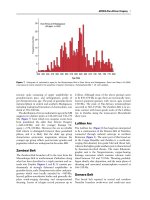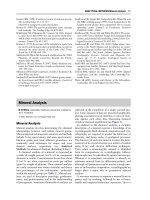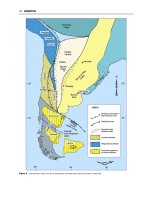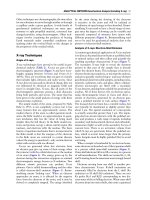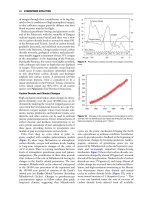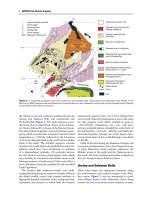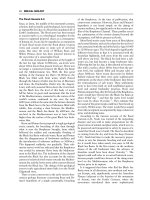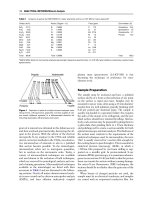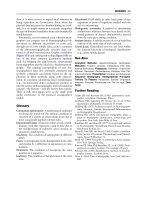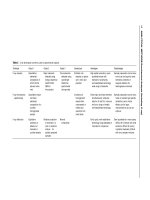Encyclopedia of geology, five volume set, volume 1 5 (encyclopedia of geology series) ( PDFDrive ) 1720
Bạn đang xem bản rút gọn của tài liệu. Xem và tải ngay bản đầy đủ của tài liệu tại đây (116.16 KB, 1 trang )
538 MINERALS/Feldspars
Figure 7 Extinction angles of plagioclase (with respect to a0 ) in
the ‘symmetrical zone’ and in sections normal to x.
The maximum extinction angles normal to {010} or
in the so-called symmetrical extinction zone are diagnostic (Figure 7). In thin section, the alternate twin
lamellae give symmetrical extinction angles on either
side of the twin plane. Such sections may be recognised by the sharpness of the composition plane between albite twin lamellae, by the equal interference
colours of the twin lamellae when the twin plane is
parallel to the vibration direction of the polarizers,
and by adjacent twin lamellae giving equal extinction
angles on either side of the twin plane. Values which
show more than a 5% divergence in the extinction
angles for adjacent twin lamellae should be discarded,
but lesser variations may be averaged; it is essential
to take measurements from several (6–12) suitable
grains, and the highest extinction angle must then
be used.
Plagioclase is the most abundant mineral in the
great majority of basic and intermediate lavas, in
which it occurs both as phenocrysts and as a groundmass constituent. In basalts, the plagioclase phenocrysts usually have a wide homogeneous core of
bytownite composition surrounded by a narrow zone
of more sodic plagioclase. The broad cores of uniform
composition indicate slow crystallization and it is
clear that the growth of these crystals occurred before
extrusion and final consolidation of the magma.
Under plutonic conditions the first plagioclase to
crystallize from most basic magmas, like that of
basalts, has a bytownite composition. In basic igneous intrusions, plagioclase sometimes occurs in feldspar-rich bands formed by the accumulation of the
primary precipitate plagioclase (the cumulus phase).
In contrast, primary precipitate plagioclase may be
absent from the ferromagnesian-rich bands in which
the feldspar occurs as a product of the crystallization
of intercumulus liquid. In the differentiated basic
rocks of layered intrusions, the compositional range
of the plagioclase is normally restricted to between
An85 and An30. In addition to the plagioclase-rich
bands of layered intrusions, plagioclase also occurs
as the only essential constituent of large masses of
anorthosite; in these rocks the plagioclase may be
bytownite, labradorite, or andesine in composition.
Plagioclase feldspars are the main constituent of
dolerites and many other hypabyssal rocks.
In metamorphic rocks, the composition of the plagioclase is generally related to the grade of the host
rock. Thus, albite is the stable plagioclase in the
chlorite and biotite zones of regional metamorphism,
occurring in such rocks as chlorite-biotite-epidotealbite amphibolites and chlorite-albite schists; the
anorthite component is not present in notable quantity until the garnet zone. Plagioclase between An5
and An20 in composition is absent in low- to mediumgrade schists; this compositional break (the peristerite
gap) corresponds with the change in grade between
the greenschist and the almandine amphibolite facies.
In calc-silicate rocks of the amphibolite facies, clear
compositional minima are seen corresponding also
with the Bøggild and Huttenlocher gaps (Figure 8).
The plagioclase feldspars of the intermediate and acid
rocks of the granulite facies commonly are sodic
andesines; thus in the rocks of the charnockite series,
the majority of the plagioclase is between An30 and
An35 in composition, although labradorite is present
in some of the more basic charnockitic rocks. Plagioclase is not stable in the P–T environment of the
eclogite facies; under these conditions the albite and
anorthite components enter the compositions of omphacite and garnet, respectively. In the thermal metamorphism of calcareous sediments plagioclase again
becomes increasingly calcic as the grade increases,
with the production of anorthite marking a high
grade of metamorphism.
In sedimentary rocks, plagioclase feldspars may
occur via a variety of sources, including detrital minerals, authigenic minerals, and the products of volcaniclastic activity. In arkosic sediments, K-feldspar is
usually dominant over plagioclase, but this varies
according to the source rock and the weathering
